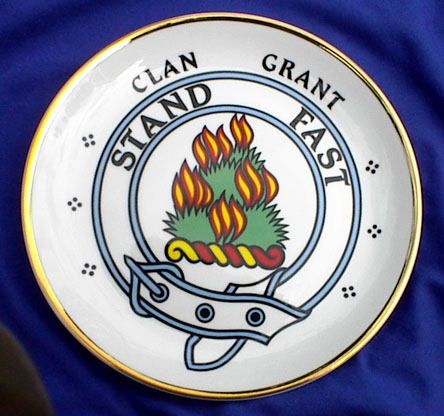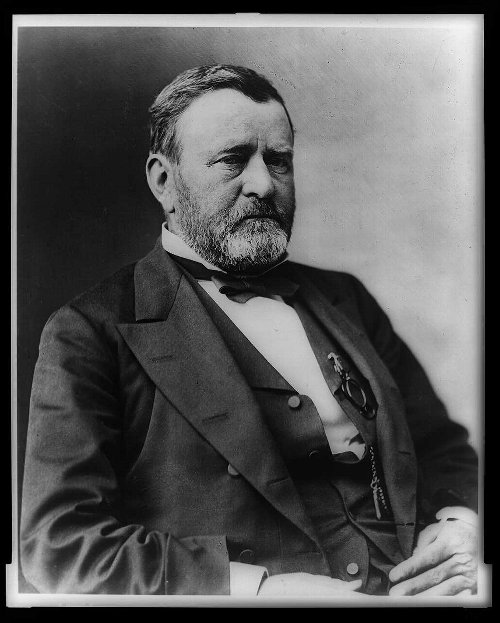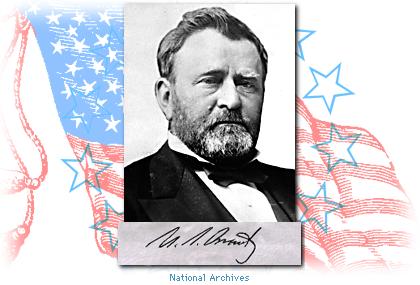 |
 |
 |
 |
|
Welcome to My Website about Anything and Everything
|
 |
Clan Badge
"A mountain inflamed, proper". This represents "Craigellachie" (pronounced "K-ray-g-El-uh-hee")
the so-called "Rock of Alarm", the gathering place for the Clan when the signal fires were lit on its summit to rally the
Clan to battle.
The badge is encircled by a buckled strap with the Clan's motto of "Stand Fast" on it. The buckled strap indicates a clansman's
allegiance to their clan and Chief, and indicates that the badge is not their own. This is as close as a clansman comes to
a "coat-of-arms".
The clan plant badge for Clan Grant is the Scots Pine - a sprig of which was typically worn in the clansman's bonnet to
identify his clan.
 The Clan Motto
The Grant's motto is "Stand Fast!", which has a few possible origins. One story suggests that the
motto stems from the original Tenons Ferme ("Stand Fast" or "Hold Firm") motto of the Norman family "Le Grand". Another
possibility is that it refers to a historical incident with the Norse King "Haaken", considered to be a distant forebear of
the Clan, according to the Clan's oral tradition.
As this story goes, Haaken was set upon by a group of enemies at which point he ripped a tree out of the ground and used
it to successfully hold off his attackers. "Stand Fast" became the motto of his family and stems from this incident. For the
latest research into the Clan's origins see the Clan Grant History site. The Clan Grant Society USA http://www.clangrant-us.org/
The Clan War Cry
The Grant's war-cry is "Stand Fast, Craigellachie!" (pronounced
"K-ray-g-El-uh-hee"). Stand Fast is the Clan's motto, and Craigellachie is the "Rock of Alarm" - the gathering place of the
Clan during times of crisis, when signal fires were lit on its summit to rally the Clan to battle.
This is the Coat of Arms of the Chief of Grant.
These arms are the Chief's personal arms and should always be identified as such. Only the Clan Chief and his immediate family
are authorized to display and wear the Coat of Arms. Note the mountain aflame depicted at the top of the coat of arms. This
is the only portion of the coat of arms that other members of the clan are allowed to display, encircled by a buckled strap
to indicate that the arms are not their own.
|
 |
History of The Clan of Grant
|
"Stand Fast, Craigellachie" (pronounced "K-ray-g-El-uh-hee"), is the Slogan of the Clan; this was used to rally the Grants
to arms from a burning beacon at the summit of Craig Elachie, a high hill in Strathspey near the town of Aviemoire.
They would assemble for battle in distinctive red and green tartan, the Grants being the first clan to adopt a common tartan. Later, the green and blue hunting tartan of the Grants became
famous as the "Black Watch" tartan, used by the regiment that was co-founded by a Grant, and which had many Grants among its original men.
Our people come from two great glens of the Highlands: Strathspey and
Glenurquhart. The first recorded Clan Chief was Sir Lawrence le Grant in the year 1263. The Present Clan Chief, Lord Strathspey,
33rd Chief of Grant, is his direct descendant.
The Strathspey seat of the Clan was Castle Grant near Grantown-on-Spey. The
Grants of Glen Urquhart and Glen Moriston are associated with the awesome Castle Urquhart which overlooks Loch Ness at the
very spot where the Monster is often claimed to have been sighted.
For more details on the history of Clan Grant, check out the excellent
information on our sister society's site, the Clan Grant Society of the U.K. or check out the new Clan Grant History site run by clan researchers and historians in the U.K. |
|
|
|
Some notable historic facts about Clan Grant:
- Clan Grant was the first clan to adopt a common "clan tartan". An edict of the Chief of Grant in 1704-5 specified that
all clansmen appearing before him should appear in tartan that was "red and green...broad springed". The same as Clan Grant wears today.
- The tartan known as "The Black Watch" was originally a Grant tartan (the Clan supposedly has the reciepts for the original order of the tartan material!). This
famous tartan, one of a handful considered to be a "national" tartan for Scotland, was thus a Grant tartan before being adopted
by the entire Black Watch regiment. Clan Grant officially has "The Black Watch" as their "Hunting" tartan for this reason.
Many other clans, such as the Campbells, wear the Black Watch or slight variations (minor variants in thread count from some
mills) as their Dress tartan. Though other clans claim to have provided the regiment with the tartan after which the regiment
is now named, it was, indeed, a Grant tartan which the regiment adopted as its own. Some clans use the Black Watch sett as
the base design for their Dress tartan and simply add a colored stripe to the overall sett.
- Clan Grant was one of the few clans not to be affected by the Highland Clearances. The "Good Sir James" Grant (Clan
Chief from 1773-1811) built the town of Grantown-on-Spey for the purpose of establishing a textile industry in the north,
and for the expressed purpose of providing for his clansmen to keep them from emigrating. While other Highlanders were emigrating
in the face of the changes that were sweeping away the old Highland way of life, Sir James Grant was busy building an entire
new Highland town to provide for his Clan. Grantown-on-Spey is a monument to Sir James's loyalty to his clansmen.
- Clan Grant was the last clan ever to be raised by the "Fiery Cross".
During a hostile election in 1820, the Chief of Grant and his sister (along with their retainers) became virtually
imprisoned in their residence in Elgin by locals who supported an opposing candidate (the Chief's brother supported his opponent).
The locals of the town grew increasingly hostile until finally they surrounded the residence of the Chief. The Chief (who
was bed-ridden at the time) and his sister, along with the other residents of the house, felt it unsafe to venture out of
the resdience, and were trapped. The Chief's sister (a lady of renowned beauty) sent out a note to the men of Strathspey via
a young boy, pleading with them to come to their aid. The loyalty of the clansmen to their Chief, and their outrage at the
afront to a lady of the Clan, was so great, that the clansmen immediately sent round the Fiery Cross. Within hours over 800
Grant clansmen had rallied and began to march on Elgin (singing Psalms since it was a Sunday). Upon seeing the approaching
Grants, roused to high fury, the terrified citizenry of Elgin who had surrounded the Chief's residence quickly melted away
and the mayor had to plead with them to keep them from causing any damage to the town. The Chief's sister greeted the Strathspey
men at the gates of the house, to thank them personally. Honor satisified and the threat having vanished, the men then marched
back to Strathspey without having caused any damage to the village. Called "The Raid on Elgin", this incident was the last
time any Highland clan was raised to battle by the "Fiery Cross".

Through the years, other families affiliated with the Grants and are considered
full clansmen. A partial list follows, spelling is not critical. Inquire if your name is not shown. For more
information on the sept names, read the article on the Septs of Clan Grant!
|
Allan |
Allen |
Allanson |
Bisset(t) |
|
Biset |
Bizet |
Bowie |
Buie |
|
Gilroy |
MacAllan |
MacAllen |
MacCallan |
|
MacElroy |
MacGilroy |
MacHurron |
MacIlroy |
|
MacKerran |
MacKerron |
MacKiaran |
Pratt |
|
Suttie |
Mores of Drumcork |
|
The family of Cairns (Kearns, Carnes, etc) wears the Grant tartan out of friendship and is welcome
to join the society!
http://www.clangrant-us.org/history.htm | |
 
Ulysses Simpson Grant was born (as Hiram Ulysses Grant) at Point Pleasant, Ohio, on April
27, 1822. He graduated from West Point in 1843 and served without particular distinction in the Mexican War. In 1848 he married
Julia Dent. He resigned from the army in 1854, after warnings from his commanding officer about his drinking habits, and for
the next six years held a wide variety of jobs in the Middle West. With the outbreak of the Civil War, he sought a command
and soon, to his surprise, was made a brigadier general. His continuing successes in the western theaters, culminating in
the capture of Vicksburg, Miss., in 1863, brought him national fame and soon the command of all the Union armies. Grant's
dogged, implacable policy of concentrating on dividing and destroying the Confederate armies brought the war to an end in
1865. The next year, he was made full general.
In 1868, as Republican candidate for president, Grant was elected over the Democrat, Horatio Seymour. From
the start, Grant showed his unfitness for the office. His cabinet was weak, his domestic policy was confused, and many of
his intimate associates were corrupt. The notable achievement in foreign affairs was the settlement of controversies with
Great Britain in the Treaty of London (1871), negotiated by his able secretary of state, Hamilton Fish.
Running for reelection in 1872, he defeated Horace Greeley, the Democratic and Liberal Republican candidate.
The Panic of 1873 graft scandals close to the presidency created difficulties for his second term.
After retiring from office, Grant toured Europe for two years and returned in time to accede to a third-term
boom, but was beaten in the convention of 1880. Illness and bad business judgment darkened his last years, but he worked steadily
at the Personal Memoirs, which were to be successful when published after his death at Mount McGregor, near Saratoga,
N.Y., on July 23, 1885.
http://www.infoplease.com/ipa/A0760603.html
|
 |
|
|
 |
|
|
 |
|
|
 |
|
|
|
|



